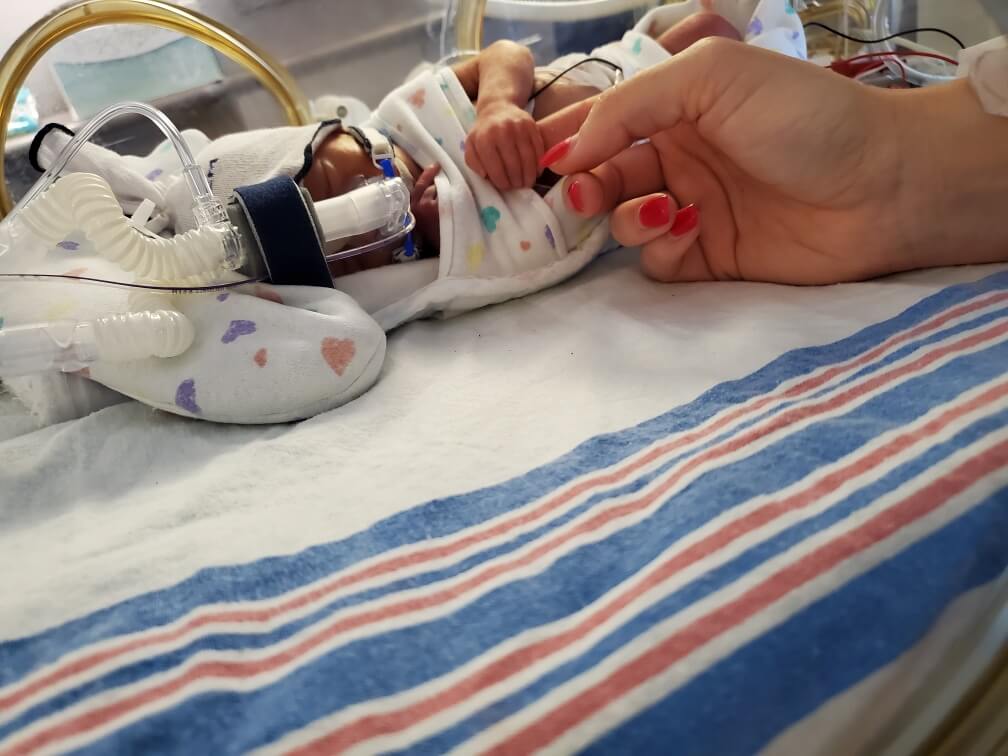A Picture is Worth More Than a Thousand Words

A very personal message from one of our valued clinical advisors and preemie moms
Live-stream Cameras; Meaningful Connection
Over the years, I have had the opportunity to provide emotional support to many mothers whose babies were admitted to the Neonatal Intensive Care Unit (NICU). As a NICU nurse, I would recite the same comforting words to each mother as she was discharged and forced to leave the hospital without her newborn. It was not until I had to leave my 28-week son, Theo, in the NICU that I fully understood the trauma of being physically separated from him. I was just starting to mentally and physically comprehend that I was no longer pregnant when I was discharged home on his sixth day of life. As I was wheeled through the lobby to go home, I sobbed as I held my empty, tender belly, longing to feel his gentle kicks again. Leaving the hospital without him was the most unnatural, painful, and confusing experience I have ever endured.
The pain of leaving my son at the hospital was softened by modern-day technology. The NICU Theo was admitted to provided web-based cameras for each baby to mitigate separation and promote family involvement. These cameras were much more than just another fancy device sitting at his bedside. His camera was my lifeline to him when I could not physically be at his bedside. The first time I logged in to view him, I felt like, despite being physically separated, we were a complete mother-baby dyad. While I was at home, I utilized his bedside camera as a baby monitor, watching him on my tablet through endless hours of pumping. This technology also allowed me to instantly view him via my cell phone while I was out and about. On the other side of the bed, his providers could send me updates through his camera’s secure web-based app. Receiving personalized messages from his team informing me he gained weight or took his entire feed, etc., eased the pain of being away from him.
Pandemic-related visitation restrictions in the NICU inhibited my family and friends from meeting my tiny bundle of joy. It was not until Theo was discharged on his 99th day of life that my immediate family had the opportunity to meet him in person. While in the NICU, his bedside camera allowed my family to view him remotely. I beamed with pride each time someone would comment on the cute outfit he was wearing or his increased alertness they witnessed while logged in watching him. The live-stream access from the camera connected my family to Theo and allowed them to familiarize themselves with his cues, preferred position, and sweet personality before meeting him. They were able to mimic the care he received when he was in-house, which was priceless as he was discharged with oxygen, a pulse oximeter, and NG tube. His camera was the perfect solution for connecting my support system with my son during a pandemic.
The nurse in me utilized his camera a bit differently than other parents might. Each time I logged in and initially saw Theo on the screen, I would subconsciously assess his little body. Although I set mental boundaries for myself regarding his care, it was ingrained in me to first quickly assess him, whether in person or on camera. His mini-assessment included monitoring his work of breathing by counting his respirations and evaluating his retractions. As his feeds and fortification increased, I was able to visualize his distended belly via his camera. It also allowed me to remotely keep an eye on his occasional, excessive weight gain and edema related to his patent ductus arteriosus.
As time went on and Theo made strides with growth and development, his camera allowed me to experience milestones when I was not at his bedside. Some parents find it stressful to see their baby crying because they dropped their pacifier. I celebrated these occasions, as I viewed them as normal neurological development. I waited a very long time to hear him cry, show interest in a pacifier, and then gain the strength to suck on his pacifier! I thrived on any “normal” developmental behaviors he exhibited. Not only did his camera allow me the opportunity to see these events, but it also better prepared me for caring for him when he finally came home.
Based on my NICU experience with my son, I highly value the use of connective NICU technologies. The bedside camera helped to fill the void when I was away from him. My experience has allowed me to empathize with other NICU families instead of sympathizing.
It was a privilege to have access to 24-hour secured, remote monitoring while my son was in the NICU. The connective technology his NICU offered filled a void for both my family and me. A picture is truly worth more than a thousand words.
